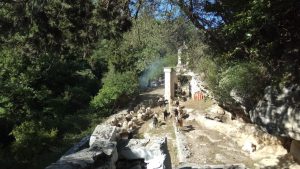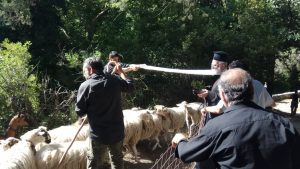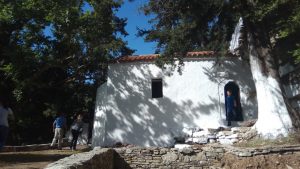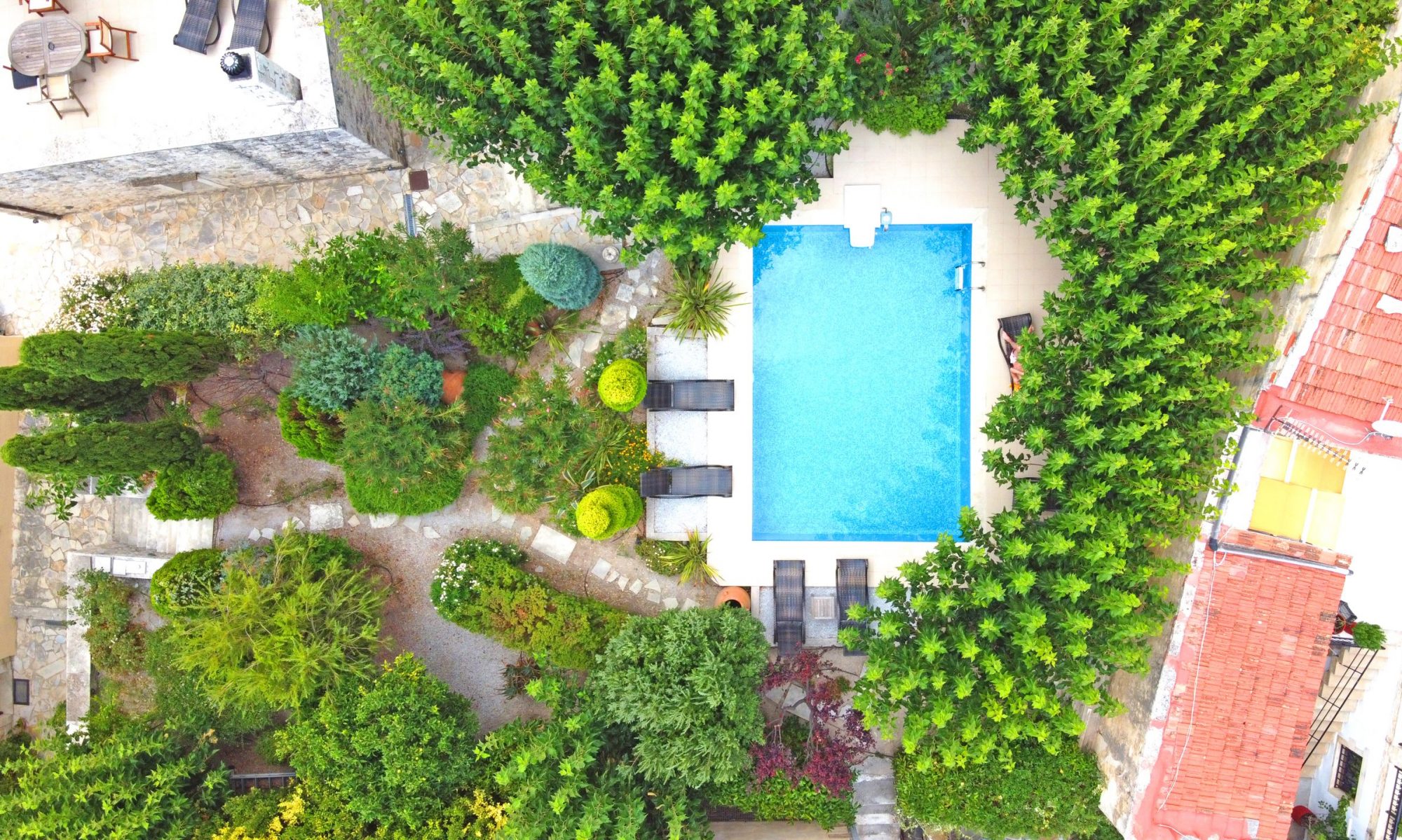On the way to the settlement of Kato Poros, east of the village of Argyroupoli, in the municipality of Rethymno, descending to a beautiful gorge, is the church and the tomb of the Saints Five Virgin’s and, next to it, five carved rooms on the rock, where, according to tradition, the ascetics virgins lived five saints, honored in the area.
The entire site is located in the area of the Greco-Roman cemetery of the ancient city of Lappa, (it is also called “Lappa cemetery”) which had recently been excavated with particularly important findings. The very tomb of the five saints, as well as the five carved rooms, where tradition places their ascetic life, are tombs of the Greco-Roman period, which were apparently used by the saints a few centuries later. It is one of the most important sanctuaries on the eastern side of the prefecture of Rethymno and one of the most beloved to our people Orthodox pilgrimages, with a history of centuries, recorded by Western European travelers since the 15th century.
 Lappa was an ancient city of Crete, extremely important and the seat of a diocese, which probably included the settlement of Rithymna (today’s Rethymno). It was destroyed by the Arabs in the 9th century AD. Today’s Argyroupoli is built on the same location site, of great historical and archaeological importance. The city of Rethymno is watered from the waters of Argyroupoli, known also as “sources of Agia Dynami” or “Springs of Argyroupoli” or “Argyroupoli waterfalls”.
Lappa was an ancient city of Crete, extremely important and the seat of a diocese, which probably included the settlement of Rithymna (today’s Rethymno). It was destroyed by the Arabs in the 9th century AD. Today’s Argyroupoli is built on the same location site, of great historical and archaeological importance. The city of Rethymno is watered from the waters of Argyroupoli, known also as “sources of Agia Dynami” or “Springs of Argyroupoli” or “Argyroupoli waterfalls”.
The Holy Five Virgins, from the time that the historical memory survives until 2014, were celebrated in their temple, which communicates with the place of their tomb, on the Tuesday of the sacramental week (Easter Tuesday) week after Easter, while on Holy Tuesday Christians from Argyroupoli, especially women, as well as from other villages in the area, went to the temple, cleaned, reminisced, lit candles and received from the holy water that gushes from the shrines of the saints. Since 2015, the Holy Metropolis of Rethymno and Avlopotamos and the parish of Argyroupoli have carried the celebration on the Saturday of Diakainisimos, as the most suitable day for the event.
 During the Feast of the Five Saints, local shepherds lead their herds to the church location, which are blessed by pastors. Then they milking their sheep and after the end of the Divine Liturgy, they offer the milk to the pilgrims and the visitors, along with a piece of fresh Cretan cream cheese and local treatments. Milk is also sent by many breeders who are unable to attend. In fact, some of them they have arranged (promised) the supply of milk, praying for their flock, especially in cases of illness.
During the Feast of the Five Saints, local shepherds lead their herds to the church location, which are blessed by pastors. Then they milking their sheep and after the end of the Divine Liturgy, they offer the milk to the pilgrims and the visitors, along with a piece of fresh Cretan cream cheese and local treatments. Milk is also sent by many breeders who are unable to attend. In fact, some of them they have arranged (promised) the supply of milk, praying for their flock, especially in cases of illness.
The names of the Saints Five Virgins are recorded in 1577 by Francesco Barozzi – who copies them from hagiography in their temple – as Thekla, Maria, Martha, Ennatha (or Enneim) and Mariamna. These saints, who are described as “Five Normal Virgos” (nuns, who lived in the world and, in parallel with their spiritual life, indulged in social work), are honored by the Orthodox Church on June 9, so For several years now, the church of the Holy Five Virgins in Argyroupoli has been operating on that day, but with less brilliance.
Due to COVID-19 pandemic measurements to stop the spread of the virus, this year the celebration had been moved to the Tuesday the 9th of June.
Undoubtedly, the most important testimony to the Holy Five Virgins is that of Francesco Barozzi, a 16th-century lord of Venetian Venetian, born in the village of Agios Konstantinos in Rethymno, near Argyroupoli. He was a mathematician with a variety of scientific interests, author of many books and founder in Rethymno of the Academy of Vivi (Living), the first club of scholars of the Renaissance in Greece. In 1577 he published the Description of Crete (Descrizione dell ’Isola di Creta), which states the following:
In the periphery of the city of Rethymno there are ruins that cover more than five miles; they belong to the ancient city of Lampi or, according to other authors, Lappi and Lappa. (…)
 In the same valley, there are five carnivores in a cave, one next to the other, carved in stone, three long and two square, which were monuments to the Lappeans. There, after the destruction of the city during the period of persecution, five virgins, Rodion, Thekla, Mariamni, Anaim and Martha, were martyred, and their bodies were placed in these five sarcophagi.
In the same valley, there are five carnivores in a cave, one next to the other, carved in stone, three long and two square, which were monuments to the Lappeans. There, after the destruction of the city during the period of persecution, five virgins, Rodion, Thekla, Mariamni, Anaim and Martha, were martyred, and their bodies were placed in these five sarcophagi.
From then until today a great miracle happens there: the carnivores are sometimes full of water and sometimes empty, sometimes some of them are full and the rest are empty, sometimes they are all half full, sometimes some full to the middle, more or less, and others completely full or completely empty. This water is not known where it comes from, because in the carnivores it is in no way distinguishable from where it gushes, nor does the cave drip from its roof, nor from where it leaves.
The water is sweet and very good, neither too cold nor too hot, but of moderate temperature, clear, clean and free from any kind of odor, easy to digest and healthy to drink. It is probably a holy grail, which is why many patients drink it with respect and are healed. Others still send there from remote areas to get water and this is maintained and never stinks. I can certify this myself, because I transferred it to Venice and it was preserved, nor did it ever smell.
This miracle appears every season of the year, both in winter and in summer. Sometimes in July, August and September, when the island’s waters are scarce, in summer it never rains in Crete, these carnivores are full of water, while in the winter the waters increase, they are empty and completely dry with dust inside. It also often happens that different people go there on the same day and some of them find them full and others empty, others half full, others one part full and the other empty; others happen to find them empty and, while they are still there, to they see them slowly filling up, without being able to locate where the water comes from, and others find them full and, while they remain there, they see them slowly emptying and remaining completely dry, without being able to see where they come from. the water leaves, which is truly wonderful and supernatural.
Due to this miracle, a small Orthodox church was built in the cave many years ago. The five virgins with their names are painted on its wall. The church is often visited by many locals and foreigners who go there to watch the service, see the miracle and drink with great reverence from that water and take with them, a fact that is unnoticeable and memorable.
“(Francesco Barozzi, Descrittione dell ‘Isola di Creta (Description of Crete) 1577/8, edited by Stefanos Kaklamanis, Vikelaia Municipal Library, Heraklion 2004, pp. 312-314; the Italian text on pp. 232-234).”
Translated from the article of Θεόδωρος Ι. Ρηγινιώτης (Theodoros I. Riginiotis):
https://rethemnos.gr/agies-pente-parthenes-argyroypoleos-r/

